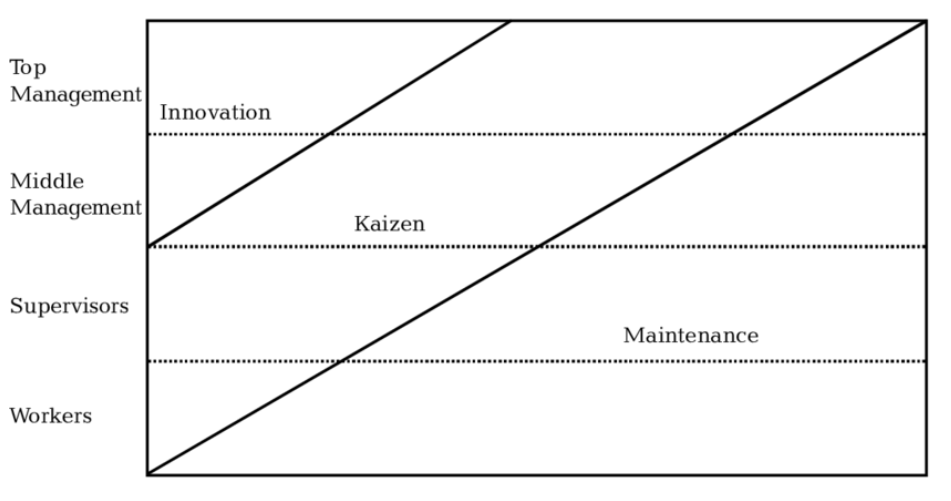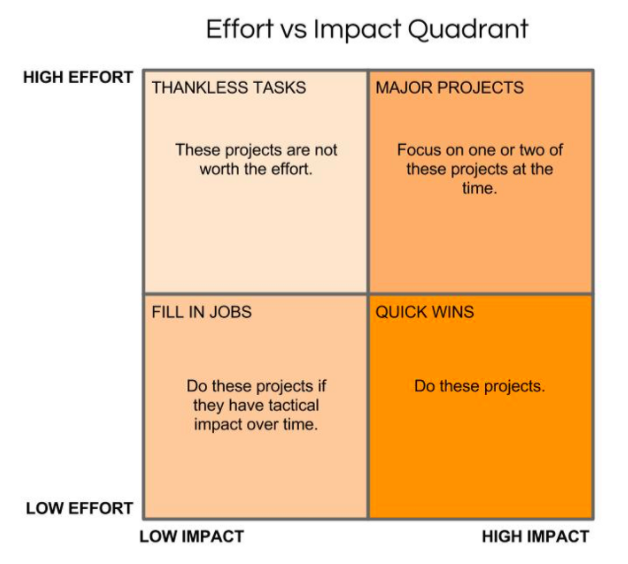Every business should be on the mission to challenge the status quo. Settling for the way things are now and not considering there might be space for improvement are major obstacles to success. In this article, I would like to dive into the topic of continuous improvement and share my thoughts on why it should be approached just as seriously as e.g. production, sales or HR.
INNOVATION AND KAIZEN
Innovation and kaizen represent two different approaches to improvement. Innovations are more radical changes, and as such require the actions of management. Managers are often the ones who introduce innovations and it is their responsibility to make all the necessary decisions. Kaizen, on the other hand, is about smaller, everyday changes, which can be introduced by anybody in the organization, irrespective of their position. Kaizen methodology emphasizes these two points:
- A series of small improvements can have a big positive impact.
- All employees should be involved in the process.
It follows that kaizen, or continuous improvement, needs to be viewed as part of company culture and “lived” by the entire organization every single day.

Masaaki Imai 1997, adapted by/taken from www.researchgate.net
MORE EMPLOYEES, MORE IDEAS? NOT NECESSARILY
Our consultants have worked on several projects implementing continuous improvement methodology in companies of various sizes. Typically, the management was aware of the importance of kaizen, and was highly interested in making it work. However, it often turned out that the same people were unable to set up the conditions in a way that would actually allow the methodology to become an integral part of company culture. It is the management’s job to encourage the employees to become involved in the process.
Continuous improvement usually gets harder to manage in larger organizations. Let’s take a look at startups as an example. In startups, everyone’s coming up with lots of ideas, they are engaged and excited to be part of the story. It is natural for them to identify opportunities for improvement; when they see a problem, they go and fix it or ask someone responsible to do it. They discuss things, ask for opinions and provide feedback. It comes easily for them as they know each other personally and are in touch on a regular basis. This works like an informal rule; it doesn’t have to be put in writing and yet everyone follows it naturally.

Once more people get on board, however, this “system” usually stops working. The newcomers don’t necessarily share the same mindset, they come to the company as employees, not entrepreneurs. They come with previous experience and expect to be asked to just do their job. They don’t think they should look around and voice their opinions on what could be improved.
This is the reality in most companies, big or small. Sometimes employees do share their ideas (some businesses use “suggestion boxes” for this purpose) but they are overlooked, in other cases there is no clarity in terms of the process itself. It often ends up with management generating ideas for the sole purpose of “innovation” (if anything is a buzzword, this is!). All of these scenarios lead to only one outcome: disengaged employees.
MY STORY (THE AUTHOR’S CONFESSION)
How do I know all that? I have first-hand experience. Several years ago, I cofounded a tech startup. There was all the excitement and engagement I described above. Ideas were flooding in, everybody was willing to pitch in. Our business grew and we hired new employees. Things were looking great – but we weren’t able to notice that the atmosphere in the company (especially the level of employee engagement) started to change. Now I know we should have stepped in and sent a clear message to the team about what we expected from them. We should have told them that we saw them as an important part of the success and appreciated their opinions. Of course we wanted to push the business forward, improve our processes and implement new ideas, but we didn’t feel the need to listen to our employees and encourage them to take part in the process. We came up with new and new ideas ourselves, thinking how well we were doing. As a result, our employees felt overwhelmed and anything but motivated.
A couple years later, I started noticing that this wasn’t an issue that only small business owners have to deal with. I have talked to managers of large organizations (mainly manufacturing companies), and they all struggle with employee disengagement. At Ennvea, we see continuous improvement as one of the most important lean methods. We know the principles work in organizations of all sizes. That’s why we are trying to implement them internally and also help our clients transform their company culture using kaizen methodology.
TOP 5 OBSTACLES TO CONTINUOUS IMPROVEMENT
1. UNCLEAR MESSAGE OF THE MANAGEMENT
One of the most common issues is that the employer doesn’t make it entirely clear that employees‘ ideas and suggestions for improvement are welcome and appreciated. It is the responsibility of the management to set up the conditions for successful “bottom-up” continuous improvement. The management must show that they value the knowledge their employees have about their work and that they are willing to listen to their employees‘ voices. But just to be clear – nothing along the lines of “Feel free to share your ideas” will do. It needs to go deeper. As was said earlier, kaizen is a part of company culture.
2. PROCESS/CHANNEL NOT DEFINED
Employees aren’t sure how exactly they are supposed to share their ideas, which channel to use, who to talk to. If they submit an idea and it doesn’t reach the right person (it may not be easy to find out who the right person is – especially in large companies), they will become discouraged. On the other hand, sometimes the process is defined but feels too complicated to the employees, which in effect prevents them from engaging.
3. LACK OF FEEDBACK
Another problem we have often encountered is that the employer collects improvement ideas but doesn’t take enough action afterwards. If an employee doesn’t receive relevant feedback, if they aren’t acknowledged, they probably won’t be willing to put in the effort again in the future and will keep their ideas to themselves – because why bother anyway? The decision as to whether an idea will be implemented or not is a completely different story. But providing feedback needs to be a natural part of the process (as should be rewarding those employees who submitted ideas that turned into successful projects).
4. INSUFFICIENT EVALUATION OF THE IDEA POTENTIAL
Not every idea is a good idea and has the potential to bring about a positive change. How to evaluate ideas efficiently? More on that below.
5. MISSING FOLLOW-UP
It’s necessary to look back and assess the actual impact the implemented idea has had. It’s not just about finishing the project on time and on budget but really looking at the results (typically savings, but don’t forget about soft KPIs such as employee satisfaction). Taking the time to perform this step also prepares the ground for an easy sharing of success stories e.g. among departments or locations of larger organizations.
HOW TO TELL WHICH IDEAS ARE WORTH IMPLEMENTING
Motivating your employees to share their ideas and collecting them is only one part of the process. The next part is choosing which projects should be implemented. In order to do that, we recommend considering these points:
- Is this idea going to bring the desired change?
- Is now the right time to implement it?
- What are the consequences going to be? (One change usually leads to another.)
- Are the employees ready to “absorb” this change or is there a chance they might get overwhelmed? Maybe you already have several ongoing projects. It’s important to use the right “dosage” when it comes to improvement projects, and provide enough time for your people to get used to new processes.
The evaluation should also include a cost/benefit analysis. However, we’re not speaking only about hard metrics such as financial savings. Soft metrics, e.g. employee satisfaction or safety, can be just as important – although more difficult to measure.
The effort vs impact matrix could also help you with the prioritization of ideas/projects.

Source: medium.com
In some cases, this step gives the responsible person (e.g. continuous improvement or HR manager) enough information to make an informed decision – usually when the cost/benefit analysis shows that the project will bring significant savings. In other cases, where even after the evaluation has been made it’s still not clear which projects should be selected, it might be worthwhile engaging the people who will be affected by the changes that a few “shortlisted” projects will bring. It should be kept as simple as possible, though – e.g. in the form of giving a “like” to the idea they like the most (rather than having to explain anything). Involving people successfully is only possible when there are no barriers in the process.
There is one more moment when an evaluation is necessary, and that is after a project has been successfully completed. Look back and assess the impact this idea has had. Did it live up to the original expectations? Is it worth repeating e.g. in another department, location, branch?
THE TAKEAWAY
- Kaizen is for everyone, not just for manufacturing companies. It needs to be integrated in company culture and the goal and process must be communicated clearly by the management.
- Remove all the barriers that could prevent people from engaging and sharing their ideas.
- Value your employees‘ effort. Make them feel they are heard and appreciated.
- Use the knowledge that already exists. Don’t dismiss any ideas just because they didn’t come at the right time.
- Measure the impact of improvement projects. Share successful projects with other departments, branches etc.
- Don’t settle for the way things are working now. Continuous improvement is a never-ending process.






